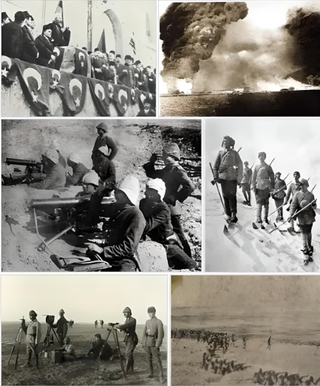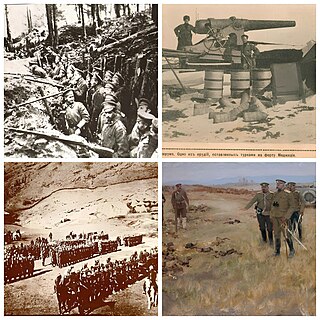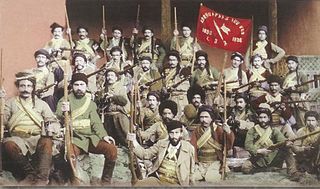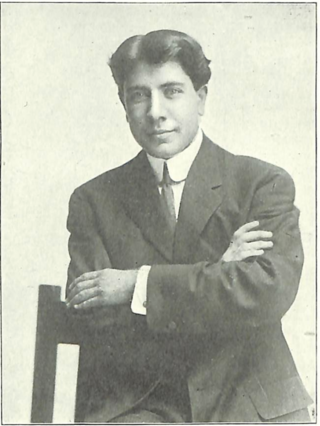
The Middle Eastern theatre of World War I saw action between 30 October 1914 and 30 October 1918. The combatants were, on one side, the Ottoman Empire, with some assistance from the other Central Powers; and on the other side, the British as well as troops from the British Dominions of Australia, Canada, and New Zealand, the Russians, and the French from among the Allied Powers. There were five main campaigns: the Sinai and Palestine, Mesopotamian, Caucasus, Persian, and Gallipoli campaigns.

The Caucasus campaign comprised armed conflicts between the Russian Empire and the Ottoman Empire, later including Armenia, Azerbaijan, Georgia, the Mountainous Republic of the Northern Caucasus, the German Empire, the Central Caspian Dictatorship, and the British Empire, as part of the Middle Eastern theatre during World War I. The Caucasus campaign extended from the South Caucasus to the Armenian Highlands region, reaching as far as Trabzon, Bitlis, Mush and Van. The land warfare was accompanied by naval engagements in the Black Sea.

Andranik Ozanian, commonly known as General Andranik or simply Andranik;, was an Armenian military commander and statesman, the best known fedayi and a key figure of the Armenian national liberation movement. From the late 19th century to the early 20th century, he was one of the main Armenian leaders of military efforts for the independence of Armenia.

The Armenian volunteer units were units composed of Armenians within the Imperial Russian Army during World War I. Composed of several groups at battalion strength, its ranks were primarily made up of Armenians from the Russian Empire, though there were also a number of Armenians from the Ottoman Empire. The Russian-Armenian volunteer units took part in military activities in the Middle Eastern theater of World War I.

The occupation of Western Armenia by the Russian Empire during World War I began in 1915 and was formally ended by the Treaty of Brest-Litovsk. It was sometimes referred to as the Republic of Van by Armenians. Aram Manukian of the Armenian Revolutionary Federation was the de facto head until July 1915. It was briefly referred to as "Free Vaspurakan". After a setback beginning in August 1915, it was re-established in June 1916. The region was allocated to Russia by the Allies in April 1916 under the Sazonov–Paléologue Agreement.

The Macedonian-Adrianopolitan Volunteer Corps was a volunteer corps of the Bulgarian Army during the Balkan Wars. It was formed on 23 September 1912 and consisted of Bulgarian volunteers from Macedonia and Thrace, regions still under Ottoman rule, and thus not subject to Bulgarian military service.

Fedayi, also known as the Armenian irregular units or Armenian militia, were Armenian civilians who voluntarily left their families to form self-defense units and irregular armed bands in reaction to the mass murder of Armenians and the pillage of Armenian villages by criminals, Turkish and Kurdish gangs, Ottoman forces, and Hamidian guards during the reign of Ottoman Sultan Abdul Hamid II in late 19th and early 20th centuries, known as the Hamidian massacres. Their ultimate goal was always to gain Armenian autonomy (Armenakans) or independence depending on their ideology and the degree of oppression visited on Armenians.
The Armenian national movement included social, cultural, but primarily political and military movements that reached their height during World War I and the following years, initially seeking improved status for Armenians in the Ottoman and Russian Empires but eventually attempting to achieve an Armenian state.

Boghos Nubar, also known as Boghos Nubar Pasha, was the son of Nubar Pasha, a three time governor of Egypt. A chairman of the Armenian National Delegation, and the founder, alongside ten other Armenian national movement leaders, of the Armenian General Benevolent Union (AGBU) on April 15, 1906, becoming its first ever president, a position he held from 1906 to 1928.

The Battle of Bitlis refers to a series of engagements in the summer of 1916 for the town of Bitlis and to a lesser extent nearby Muş, between Russian Imperial forces and their Ottoman counterparts. The town was the last stronghold of the Ottoman Empire preventing the Russians from entering Anatolia and Mesopotamia. Part of the battle is known as Battle of Muş

The Persian campaign or invasion of Iran was a series of military conflicts between the Ottoman Empire, British Empire and Russian Empire in various areas of what was then neutral Qajar Iran, beginning in December 1914 and ending with the Armistice of Mudros on 30 October 1918, as part of the Middle Eastern Theatre of World War I. The fighting also involved local Persian units, who fought against the Entente and Ottoman forces in Iran. The conflict proved to be a devastating experience for Persia. Over 2 million Persian civilians died in the conflict, mostly due to the Armenian genocide by the Ottoman regime and Persian famine of 1917–1919, influenced by British and Russian actions. The Qajar government's inability to maintain the country's sovereignty during and immediately after the First World War led to a coup d'état in 1921 and Reza Shah's establishment of the Pahlavi dynasty.

Vahan Hovhannesi Totovents was an Armenian writer, poet and public activist.
The Battle of Ardahan was fought between 25 December 1914 and 18 January 1915 and was an Ottoman military operation commanded by German Lt. Col. Stange to capture the city of Ardahan and cut the Russian link to Sarikamish–Kars line, supporting the Battle of Sarikamish.

Krikor Amirian was an Armenian Revolutionary, who participated in the establishment of the First Republic of Armenia.

Arshag Nersesian, better known by his nom de guerre Sebouh or General Sebouh, was an Armenian military commander. He was the right-hand man of General Andranik Ozanian.

The Battle of Holy Apostles Monastery was an armed conflict between Ottoman Empire forces and Armenian militia at the Holy Apostles (Arakhelots) Monastery near Mush, Ottoman Empire in November 1901.

Sarkis Jebejian was an Armenian military leader, the head of the self-defense of Hadjin (1920).

The Greek Volunteer Legion was a volunteer military corps formed by Greeks and other Balkan Christians that fought for the Russian Empire during the Crimean War. It was formed in the Danubian Principalities in March 1854, and some elements participated in the final engagements of the Danube theatre, before the Russian troops abandoned the Principalities. From there the Legion was sent to the Crimea, where it fought in the Siege of Sevastopol. In 1855 the Legion received the title Greek Legion of Emperor Nicholas I. After the end of the siege, the bulk of the Legion was discharged, and the remainder of the unit was disbanded after the war's end in March 1856. Most of the volunteers returned to their homelands, although a few settled in Russia.



















